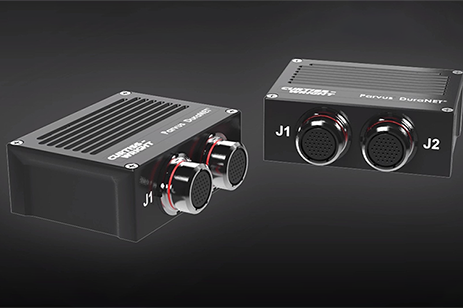
This video provides a brief product demo for the Parvus DuraNET 20-11 miniature rugged 8-port Gigabit Ethernet switch, including a few basic modes of operations for its Web GUI and CLI management interfaces. Along with showing how the system is cabled-up, the video illustrates how to configure port link rates, VLAN settings, port mirroring, save start-up configuration files, and view port statistics.
The video discusses:
- Connecting the connectors to the unit
- Connecting a computer to the unit to configure the unit
- Powering up the unit
- Testing the unit to show that it powers up in an unmanaged configuration
- Using the Graphical User Interface (GUI) to configure VLANs, etc.
- Using the command-line interface
Video Transcript
Hello, my name is Seamus Connor, an engineer at Curtiss-Wright. I will be giving you a quick introduction to the Parvus DuraNET 20-11.
The DuraNET 20-11 is a fully managed switch with many features, but in this video, we will focus on the simplest modes of operation.
First, let's take a look at the cabling up of the system. There are 3 connectors: 1 for power and 2 larger MIL round connectors for Ethernet and management interfaces. In this demo, we will cable up 2 test PCs and pass traffic between them.
After the switch is booted, you can see that it has all of the functionality of an unmanaged switch in its default configuration. Here you see pings being passed between 2 test PCs. And here you see iperf being run between those test PCs.
Now, let's step through the web GUI and look at a few things that it exposes.
- First, we need to point the browser to the GUI and log in.
- The first page shown is a high-level status page. This page gives you the status of each port at a glance. Since we have ports 1 and 2 connected, we see that those are lit up as green. The unconnected ports are shown as black.
- Let's step into the configuration section of the GUI. Here we can control all of the fully managed switch features. Let's look at a few. On the Configuration > Ports page, we can configure the physical ports including setting the link rate or fully disabling a port. Here I set the link rate to 100Mbps FDX (full-duplex), allow the link to re-negotiate with the test PC, and then return it to the auto setting which then negotiates to 1Gbps full-duplex.
- Now, let's look at Configuration > VLANs (Global VLAN Configuration). To add a VLAN, first, update the list at the top of the screen with each range of VLAN numbers allowed in your configuration. Next, assign VLANs to each port. Note that the switch supports multiple modes of VLANs.
- Now, let's take a look at Configuration > Mirroring (port mirroring). This allows you to take traffic on any port and mirror it to your monitored port allowing for the traffic between 2 devices to be monitored. Here I configure the monitored port as port 2 and I enable monitoring of all traffic on port 1.
- Next, we should save our configuration so that it shows up next time that we boot. To do that, we need to go down into the Maintenance section of the GUI. In the maintenance section, we could also undo our changes by restoring factory defaults or loading the startup-config. (To save our configuration select Maintenance > Configuration > Save startup-configuration > Save Configuration. When startup-config saved successfully appears on the screen, your configuration has been saved.)
- Let's look at one more thing in the Monitor section of the GUI. Under Traffic Overview, we can view detailed statistics of each port including packets transmitted and received.
Let's move away from the web GUI to the serial console interface. Here we can configure all of the same features that are available via the web GUI. Let's take a look at port status using the show command. You can see the same information here that was available via the web GUI. Next, let's step through the configuration of the system using the show command. Here we can see all of the configuration changes made using the web GUI.
Thank you for watching! I hope this overview has been helpful. If you have any questions or need additional information, please visit us at https://www.curtisswrightds.com.